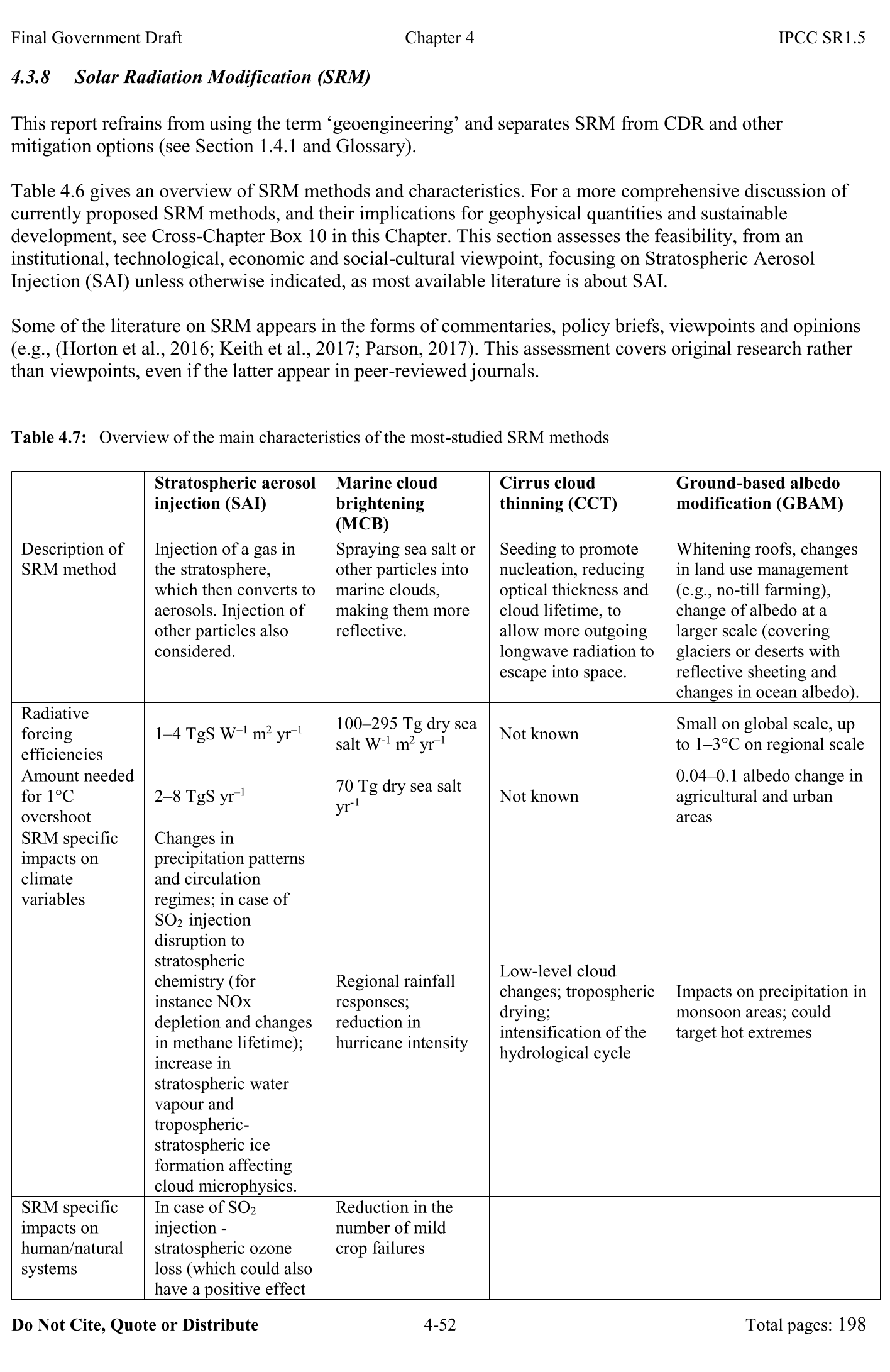It looks like you're using an Ad Blocker.
Please white-list or disable AboveTopSecret.com in your ad-blocking tool.
Thank you.
Some features of ATS will be disabled while you continue to use an ad-blocker.
6
share:

The IPCC is suggesting that use of atmospheric aerosol injection (Solar Radiation Modification) can economically provide cooling for the planet.
See Chapter 4 page 52 of the latest IPCC report.
www.ipcc.ch...

edit on 11-10-2018 by SofaKing because: (no reason given)
a reply to: SofaKing
I found myself on page fifty. Fertilising the ocean.
Page 52,
If these people would just stay at home things could have a chance to re-balance.
I found myself on page fifty. Fertilising the ocean.
Page 52,
They didn't refrain, they said it.
This report refrains from using the term ‘geoengineering’ . . .
If these people would just stay at home things could have a chance to re-balance.
a reply to: SofaKing
Because of course they do.
An interesting flashpoint (ahem) I’ve recently discovered. Besides the assumption this stuff make sure it back to earth, what about the reflection of radiance and Solaris radiation back into the stratosphere??
I mean, for those of us a who wonder of course
Because of course they do.
An interesting flashpoint (ahem) I’ve recently discovered. Besides the assumption this stuff make sure it back to earth, what about the reflection of radiance and Solaris radiation back into the stratosphere??
I mean, for those of us a who wonder of course
Great find , bottom corner note noted !!
It explains exactly what we'd deducted about why this happens .
It explains exactly what we'd deducted about why this happens .
How does this equate to chemtrails being a reality for years and years? That is the claim when it comes to that conspiracy.
Here are a few rhetorical questions for those who might believe in all this as an ongoing reality.
1. what flight level are they proposing using for SRM?
2. what flight level do passenger jets fly at?
3. where do these planes that have been spraying the skies fly out of? (where do they originate from?)
4. If it's still being discussed as a possibility, then how has it been ongoing since 2000?
If you really want to believe in chemtrails, sweet, Bigfoot needs your attention as well. But to date, bigfoot has more credible evidence than chemtrails.
Here are a few rhetorical questions for those who might believe in all this as an ongoing reality.
1. what flight level are they proposing using for SRM?
2. what flight level do passenger jets fly at?
3. where do these planes that have been spraying the skies fly out of? (where do they originate from?)
4. If it's still being discussed as a possibility, then how has it been ongoing since 2000?
If you really want to believe in chemtrails, sweet, Bigfoot needs your attention as well. But to date, bigfoot has more credible evidence than chemtrails.
originally posted by: network dude
But to date, bigfoot has more credible evidence than chemtrails.
Not true old friend. Weather Modification and the M.I.C have been a thing since WWII. The global warming aspect is newer but even that's been around for decades now. If our atmosphere is messed up it was probably by idiot defense scientists with a big budget, little common sense, and a skewed morality.
edit on 11-10-2018 by The GUT because: (no reason given)
a reply to: The GUT
Cloud seeding, hail suppression is indeed real, and happens even today, it's not supposed to be used in aggression, how true that is remains to be seen. When I speak of the nonsense of this, I am referring to the white lines in the sky that are contrails made by the combustion of fuel in a -60 degree environment. Whey they are pointed to, as with the picture in the OP, and called something other than contrails, my derp radar goes off.
SRM is a real proposal, and might have even been tried already, though it's never been admitted to yet. But it is proposed to happen in the Stratosphere, which is well above regular flight levels. It's appearance should be nothing noticeable to us, based on the science explained by David Kieth.
Or is there another aspect you are thinking of?
Cloud seeding, hail suppression is indeed real, and happens even today, it's not supposed to be used in aggression, how true that is remains to be seen. When I speak of the nonsense of this, I am referring to the white lines in the sky that are contrails made by the combustion of fuel in a -60 degree environment. Whey they are pointed to, as with the picture in the OP, and called something other than contrails, my derp radar goes off.
SRM is a real proposal, and might have even been tried already, though it's never been admitted to yet. But it is proposed to happen in the Stratosphere, which is well above regular flight levels. It's appearance should be nothing noticeable to us, based on the science explained by David Kieth.
Or is there another aspect you are thinking of?
a reply to: network dude
And....
Who is making the chemicals. How are they shipped to the airport. Where are they stored at the airport. Where is the special tank in the jet? If in the fuel, what about wear and tear on the engines. The chemicals causing inefficiency in the engines. The decreased range from chemicals being stored in the fuel, or onboard. How does the chem trail equipment change maintenance schedules? Chem trails fail on many levels.
And....
Who is making the chemicals. How are they shipped to the airport. Where are they stored at the airport. Where is the special tank in the jet? If in the fuel, what about wear and tear on the engines. The chemicals causing inefficiency in the engines. The decreased range from chemicals being stored in the fuel, or onboard. How does the chem trail equipment change maintenance schedules? Chem trails fail on many levels.
edit on 11-10-2018
by neutronflux because: Fixed more
edit on 11-10-2018 by neutronflux because: Fixed more
a reply to: SofaKing
and this has what to do with the white lines that make the x patterns the sky in the picture you posted?
The UN's IPCC advocates geoengineering aka chemtrails.
The IPCC is suggesting that use of atmospheric aerosol injection (Solar Radiation Modification) can economically provide cooling for the planet.
and this has what to do with the white lines that make the x patterns the sky in the picture you posted?
originally posted by: network dude
a reply to: The GUT
But it is proposed to happen in the Stratosphere, which is well above regular flight levels.
That is not necessarily true. The stratosphere begins just above the tropopause, which can be as low as 23,000 feet near the poles. It is usually at about 33,000 at mid latitudes and 66,000 feet near the equator. Because (primarily) of airframe pressurization limits (think Comet) older airliners usually cruise at the low to mid 30s. The certified service ceiling for all 737s, except the 737-max, is 37,000 feet. On the Max, it is 41,000 feet. On the 757, it is 42,000 and on the 767 it's 43,000. I fly a 747-400 and we're certified to 45,000 feet (with pressure demand oxygen delivery masks. However when we're hauling passengers instead of freight, we don't like to go that high. At 45000 feet, the partial pressure of ambient oxygen is only about 24mmHg. Since alveolar oxygen partial pressure is 104 mmHg, if cabin pressure is lost, your lungs try to pressurize the cabin instead of the other way around. Since the passenger emergency oxygen system is a demand re-breather type and not a pressure system, they are only effective for a short time. So if the cabin is lost, it's time to (very) quickly turn ignitors on, pull all thrust levers (throttles) closed, throw the speed brakes out, kill the autopilot, and shove the nose over to dive at .88 Mach or Vmo and head for 14000 feet or lower (unless you are over the Rockies, Alps, Himalayas or other granite clouds.
edit on 11-10-2018 by F4guy because: forgot about passenger safety
new topics
-
ILLUMINATION: Dimensions / Degrees – Da Vincis Last Supper And The Philosophers Stone
Secret Societies: 4 hours ago -
Just Sick of It! Done! Can't take it anymore!
General Chit Chat: 5 hours ago -
Speaking of Pandemics
General Conspiracies: 7 hours ago -
Stuck Farmer And His Queue Jumping Spawn
Rant: 7 hours ago
top topics
-
Speaking of Pandemics
General Conspiracies: 7 hours ago, 8 flags -
Paradox of Progress
Ancient & Lost Civilizations: 15 hours ago, 7 flags -
ILLUMINATION: Dimensions / Degrees – Da Vincis Last Supper And The Philosophers Stone
Secret Societies: 4 hours ago, 6 flags -
Stuck Farmer And His Queue Jumping Spawn
Rant: 7 hours ago, 4 flags -
Just Sick of It! Done! Can't take it anymore!
General Chit Chat: 5 hours ago, 4 flags
active topics
-
Candidate Harris Supporter MARK CUBAN Says Trump Has No Smart-Intelligent Women in His Orbit.
2024 Elections • 78 • : Oldcarpy2 -
Musk calls on King Charles III to dissolve Parliament over Oldham sex grooming gangs
Mainstream News • 137 • : fringeofthefringe -
Post A Funny (T&C Friendly) Pic Part IV: The LOL awakens!
General Chit Chat • 7992 • : underpass61 -
Paradox of Progress
Ancient & Lost Civilizations • 7 • : BeyondKnowledge3 -
-@TH3WH17ERABB17- -Q- ---TIME TO SHOW THE WORLD--- -Part- --44--
Dissecting Disinformation • 3933 • : Crazierfox -
ILLUMINATION: Dimensions / Degrees – Da Vincis Last Supper And The Philosophers Stone
Secret Societies • 4 • : CarlLaFong -
Just Sick of It! Done! Can't take it anymore!
General Chit Chat • 8 • : BeyondKnowledge3 -
DONALD J. TRUMP - TIME's Most Extraordinary Person of the Year 2024.
Mainstream News • 47 • : Oldcarpy2 -
Tesla Cybertruck Explodes in Front of Trump Hotel in Las Vegas
Mainstream News • 225 • : BeyondKnowledge3 -
Winter Storm
Fragile Earth • 26 • : Asktheanimals
6
